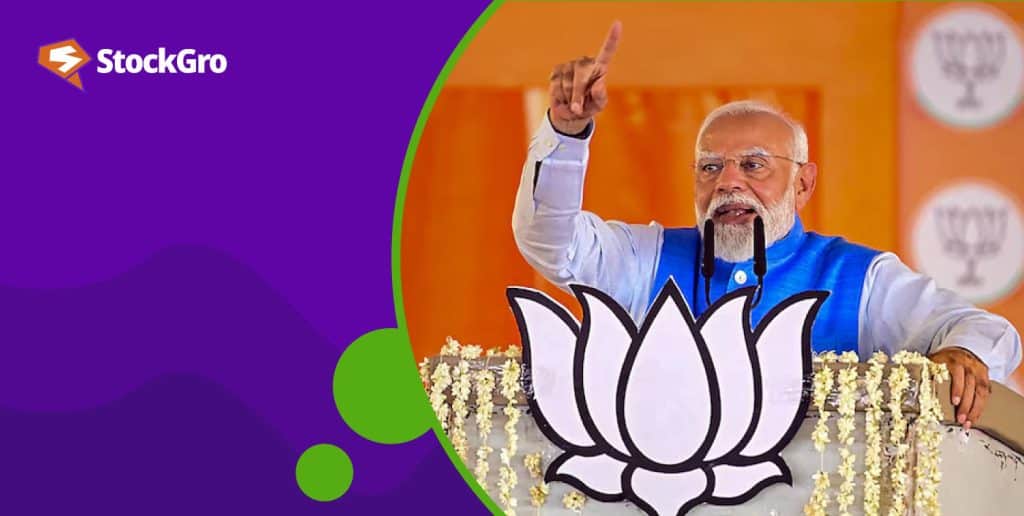
As Prime Minister Narendra Modi begins his third term, the Indian economy is set for another significant transformation. To make India a $5 trillion economy, Modi 3.0 is likely to focus on sectors that can spur growth, create jobs, and boost India’s global competitiveness.
Investors and businesses are keenly watching BJP stocks as the new government takes charge. They should pay attention to the sectors that are expected to benefit from the government’s policies and initiatives.
Let’s explore further into the sectors that can benefit as Modi 3.0 takes charge!
FMCG
Investors are closely monitoring BJP-related stocks amidst the changing political landscape, and FMCG is one of them.
For years, the Fast-Moving Consumer Goods (FMCG) sector has served as a foundational pillar of the Indian economy, mirroring the consumption trends of the burgeoning middle class. As one of the key contributors to the economy, it accounts for the fourth-largest sector, with household and personal care products dominating 50% of the market share.
Over the past year, sectors like FMCG, cattle, consumer durables, and fertilisers have underperformed due to weak rural demand caused by low income, unfavourable weather, and high inflation. This reduced agricultural production and purchasing power. However, rural demand is gradually recovering due to declining inflation and strategic company initiatives.
The new coalition government may take a more populist stance in response to rural unrest caused by stagnant incomes and limited job creation. Increased government expenditure and beneficiary schemes for the underprivileged are anticipated, positively impacting rural demand and benefiting sectors like FMCG and consumption.
Must read: Fast-Moving Consumer Goods (FMCG) Sector- A Safe Haven in Bear Markets?
Infrastructure and manufacturing
Infrastructure and manufacturing are central to Modi’s vision of an independent India. The government’s commitment to modernising infrastructure is expected to fuel growth in manufacturing.
The National Infrastructure Pipeline (NIP), with planned investments of US$1.4 trillion by 2025, will drive sectors like construction, steel, and cement. Urban development initiatives like the Pradhan Mantri Awas Yojana (PMAY) will further stimulate the construction sector.
Previous terms have seen a focus on infrastructure development in metros, tier I, and tier II cities, creating new commercial and housing opportunities. Investing in infrastructure enhances connectivity, boosts real estate, and strengthens the economy, with expectations for increased focus on smart cities and transportation networks.
You may also like: India’s billion-dollar infrastructure industry: How to invest in it?
Industrial, defence, capital goods and power
India’s defence sector is undergoing a significant overhaul. Increased spending and a push for domestic production (indigenisation) are driving this transformation. The Make-in-India program is a key factor, with defence exports reaching a record ₹21,083 crores, a jump of over 30% year-on-year.
Beyond defence, the capital goods sector is another area ripe for growth. This sector encompasses machinery for building other machines, aerospace, electrical equipment, and defence. Making up 12% of India’s total manufacturing output, this sector is primed to draw substantial investments.
Another promising area is the power sector, notably renewable energy. India’s focus on sustainable development is leading to heavy investments in clean energy sources. This government commitment is expected to propel the renewable energy sector forward, making it a prime investment opportunity.
Automobiles
The automobile sector is undergoing a significant transformation, fueled by advancements in electric vehicles (EVs) and the government’s initiatives for cleaner mobility solutions. The Faster Adoption and Manufacturing of Hybrid and Electric Vehicles (FAME) scheme aims to boost EV adoption through subsidies and infrastructure development, including charging stations.
Meanwhile, the traditional internal combustion engine (ICE) vehicle market continues to be substantial, with increasing middle-class incomes driving car sales. The automotive sector’s ancillary industries, such as auto components and battery manufacturing, are also poised for growth as the sector moves towards greater electrification.
Also read: Automobile industry in India
Tourism and hospitality
Tourism holds significant potential for job creation and economic growth. Contributing 7-8% to GDP, its development can generate income and foreign currency. With India’s diverse culture and heritage, there’s ample opportunity for tourism growth.
As the fastest-growing economy and fifth-largest globally, India sees a rise in business and conference-related tourism, hosting events like the G20. Rising incomes fuel aspirations for travel, boosting tourism’s contribution to consumer spending.
Under the Modi 3.0 era, the government will offer long-term interest-free loans to States for developing iconic tourist centres, fostering infrastructure growth and global branding. Additionally, it will also support the development of spiritual tourism, aiming to enhance India’s tourism potential.
Sectors that may normalise
The effect of election results on sectors is a key consideration for savvy investors. While several sectors are poised for growth, some sectors related to railways and Public Sector Undertakings (PSUs) that have seen significant growth in anticipation of high growth may normalise in Modi 3.0.
These sectors have already experienced substantial growth, and the pace may stabilise as the market adjusts to the new normal.
Narendra Modi’s stock portfolio is of interest to many, given his influence on the economy. Thus, assessing the performance of Modi stocks in light of evolving government policies is essential.
Conclusion
As Modi 3.0 takes charge, several sectors of the Indian economy are poised for significant growth. The FMCG and consumption sectors, infrastructure and manufacturing, industrial, defence, capital goods, power, automobiles, housing, and tourism are key areas to watch.
While some sectors may normalise, the overall outlook for the Indian economy remains positive, with continued reforms and investments driving growth. Investors should keep a close eye on these sectors to capitalise on the opportunities presented by Modi’s third term.

